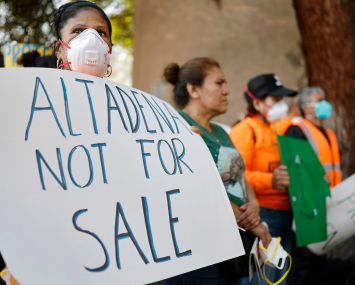The SEC Climate Disclosure Rules Are Here. Now What?
Finding the positive in all the negative surrounding the SEC’s new greenhouse gas rules
By Anna Staropoli April 3, 2024 10:00 am
reprints
The clock is ticking for the biggest players in American business to disclose how much they contribute to climate change. And enforcement isn’t coming from environmentalists. It’s coming from the folks who regulate the stock market.
After years of buildup, the U.S. Securities and Exchange Commission (SEC) on March 6 approved its long-
anticipated climate-related disclosure rules. The framework for reporting climate-related information and risks won’t start to come into effect until 2026, though the commercial real estate industry in particular has long been grappling with the regulations’ big picture. Across asset types, many of the necessary pieces to track, report and, ultimately, reduce emissions are already in the works.
“The rules mandate that all publicly traded companies must disclose material, climate-related risks and related risk management and oversight,” said Rex Hamre, senior vice president and national sustainability director at JLL.
Specifically, the policy singles out the disclosure of what are called Scope 1 and 2 emissions, first for larger publicly traded companies and eventually by decade’s end for smaller ones, as well. Scope 1 refers to the most direct greenhouse gas emissions, such as the gas or oil that’s burned for heating, while Scope 2 encompasses emissions from sources like electricity. “So, the energy and emissions used on site,” Hamre explained.
Previous proposals for the SEC’s now-approved rule also included Scope 3 emissions, or indirect emissions from an organization’s supply chain and third-party contractors. After proposing the Scope 3-inclusive rules in March 2022, the SEC received pushback from Republican officials, who cited the difficulties and costs in reporting such emissions.
Yet, even after eliminating Scope 3, the SEC’s framework has proven divisive, sparking backlash from all parties. The day after the ruling’s announcement, 10 Republican-led states filed lawsuits against the restrictions. (Now, more than 20 lawsuits have been filed.) Meanwhile, climate groups and Democratic leaders have argued that the SEC’s decision wasn’t strong enough.
For commercial real estate, however, politics may be a moot point. “You still have to follow the rules, right?” said Heather McGeory, head of sustainability at proptech venture capital firm Fifth Wall. “And don’t assume, because there’s lawsuits, that this is gonna get jammed up in courts for many, many years, because the reporting actually starts very soon.”
The first filing in 2026 will cover activities of 2025’s fiscal year, though the onset of disclosure legislation may not be as stark as it seems. Encouraged by both tenant and investor demand — as well as local, state and even global regulations — many real estate companies are already tracking and disclosing their emissions. The value of the SEC framework, then, lies in the opportunities it creates for both increased transparency and industry-wide consistency.
As companies increasingly adopt technology-driven data solutions and increase their awareness about climate impact, the SEC’s rules may prove a building block for additional rules — like Scope 3 — and future greenhouse emissions reductions.
A natural progression
The SEC’s decision may be new, but it branches off widespread industry trends. Many companies are already tracking their emissions, whether of their own volition or forced to by different rulings.
For the latter, both global and local reporting standards — such as Europe’s CSRD or California’s emissions reporting and climate risk assessment laws — often require companies to not only disclose their Scope 1 and 2 emissions, but also their Scope 3. Local laws have been significantly driving the United States’ marketplace over the last several years, said Hamre.
“We’re not in a space where there should be a lot of companies scrambling to figure out what is Scope 1 emissions or what is Scope 2 emissions,” McGeory said.
In the past, however, disclosures have often taken shape through separate, stand-alone ESG and sustainability reports, said Elena Lebensbaum, director of sustainability at Time Equities. The SEC’s rules will require disclosure in a company’s annual financial reporting, which will bring additional attention to the information.
“These kind of regulations — if they’re workable and they’re fair — are important because they create consistency in the market,” said Diane Hoskins, co-CEO at architecture firm Gensler.
Come 2026, companies will have a baseline set of SEC disclosure requirements they know they have to fulfill, resulting in a shift toward disclosure as standard practice. Such consistency helps evaluations, as buildings will be measured by the same metrics. It also creates more reliable pricing for real estate assets, said Hoskins.
Even when regulation hasn’t dictated disclosure, many companies have chosen to report their emissions. Market demand has been moving the dial, said Hoskins, who called such demand one of the largest drivers of disclosure over the last 10 years. She predicts that the SEC rules will now have a flywheel impact.
“Sustainability credentials are increasingly impacting brand and reputation,” said Hamre. “So investing in, disclosing and implementing sustainability measures right now can deliver long-term returns.”
Both tenants and investors have expressed curiosity about a building’s emissions and climate risks. Commercial tenants, in particular, have already been requesting data around utilities, and are increasingly interested in green clauses in leases, said McGeory.
Meanwhile, for investors, disclosure helps protect an investment, said Hoskins. There are green funds specifically set up to bring financing to green buildings — but they lack a measuring stick to say whether or not a building is green, she added.
For investors, disclosure is, essentially, a form of risk management, said Lebensbaum. Investors want greater transparency, as well as accountability around both environmental performance and the climate impacts of business operations, said Hamre.
Who needs to comply?
That’s not to say everyone will seamlessly adjust to the SEC’s rules. There will still be a shift, said McGeory, particularly with publicly traded real estate investment trusts, which will be required to disclose their climate goals.
Most REITs have already been tracking and disclosing their greenhouse gas emissions, said Lebensbaum. But if they haven’t previously shared their goals, the SEC’s rules are likely to spark internal, active engagement. McGeory foresees more conversations about long-term planning to decarbonize Scope 1 and 2, as well as about what goals can or should be set.
Likewise, large companies — even if they have yet to disclose information publicly — are likely better equipped for compliance, as many have already been tracking their emissions. Smaller companies may have to build a support system, and therefore experience additional costs in data collection and assurance, said Lebensbaum.
“It’s only the largest companies — those who have shares out there of $700 million or more — [that] are going to be required to start complying with this reporting in the near term,” said Hoskins, though that doesn’t mean smaller companies are off the hook. “Even a smaller company, if they’re seeking debt or equity from a registered financial institution … they’re going to need to also meet these requirements.”
The good news, she said, is that regulations are being phased in. To adjust for SEC compliance, companies of all sizes can turn to the basics.
“Assessing the emissions of all of your properties in your portfolio, whether you’re a large company or a small company, is going to be essential,” said Hoskins. “ ‘What is a climate risk assessment?’ is frankly one of the biggest questions even in this disclosure rule.”
She believes companies will iron out these questions, and different methodologies will crop up over the next few years.
Then, there are different implications of the regulations, depending on both the nature of the company and a building’s asset type. A homebuilder, for instance, will be concerned about Scope 1 and 2 emissions and therefore the construction process, but addressing those concerns won’t necessarily create the most energy-efficient house. For builders, energy would fall under Scope 3 emissions, said McGeory.
In retail and industrial applications, however, it is tenants who often bear the most responsibility. They typically have triple-
net leases, so they’re in charge of a building’s energy consumption and have to report associated data. With Scope 3 emissions excluded, landlords and owners don’t have to report that information.
“In the real estate sector, I think there’s a lot of disaggregation across owners, operators, tenants and then how energy use is tracked, who’s paying for it, and how to make changes within that,” said McGeory.
Such disaggregation has slowed efficiency, but as the SEC rules encroach, tenants will have to share private information, increasing the awareness of both investors and owners. This, in turn, may result in reduced emissions, though they aren’t mandated — yet — by the SEC.
“Right now, the rule doesn’t say what your greenhouse gas emission impact should look like; there are no limits, there are no penalties,” said Lebensbaum, with the caveat that those inclusions are likely to come.
Even if the rules don’t demand reductions, emissions remain climate risks that can harm business. “You’re going to activate to try to reduce those emissions,” said McGeory, “because you want to deliver to your shareholders and demonstrate that you’re making change.”
Taking the steps to disclose climate risks will likely make reducing emissions all the easier. Before a company can disclose its footprint — never mind reduce it — it needs to know where it’s coming from. Collecting data and tracking greenhouse gases therefore allows for a better climate strategy with long-term benefits.
Data comes first
Data will help companies strategically prepare for the future — not just five years from now but 10, 20 and more, said Lebensbaum. Companies should therefore start preparing for SEC compliance by conducting a baseline greenhouse gas data assessment for their Scope 1 and 2 emissions, said Hamre.
Doing so, however, is easier said than done.
“We need more just to streamline and improve the quality of the data,” said Lebensbaum, because reporting can prove complex and require a lot of labor. There’s a need for better data management tools, as well as submetering, she added. That way, tenants and owners can collect more granular data on energy consumption.
Technology, then, is essential and can help companies plan for SEC compliance in more efficiently and cost-effective ways. If you’re tracking your emissions manually in an Excel file, for instance, you may want to consider getting a software platform partner, said McGeory. (Hamre’s JLL, for instance, recently partnered with climate risk analysis firm Jupiter Intelligence.) AI may also help create benchmarks, said Hoskins.
Already, real estate has recognized the importance of technology and is collecting data, though Hamre believes these trends will expand significantly as the SEC’s time frame draws closer.
“I think you hear a lot of the time that we’ve accomplished all the low-hanging fruit in the industry,” said Hamre, who defined low-hanging fruit as one- to three-year simple paybacks. “And I’m here to say that there’s actually still a lot to be accomplished from that perspective.”
Specifically, more energy and decarbonization auditing needs to happen across building portfolios, he said. Through those efforts, companies can find quick operational improvements, such as building automation system upgrades.
More than the minimum
Although 2026 is the next milestone, doing more than the SEC’s minimum requirements may be in a company’s best interests. Gensler, for instance, is meeting with concrete suppliers to help them understand the importance of decarbonizing concrete for both Gensler and Gensler’s clients.
For the design and architecture firm, concrete falls under embodied carbon and is therefore Scope 3. (Gensler, however, is set up as an employee stock ownership plan rather than a listed company, and therefore not required to file.) However, “A key part of our strategy is don’t just stay in our own lane,” said Hoskins. She highlighted real estate as an ecosystem of clients, developers, contractors and suppliers, regardless of the Scope 1, 2 and 3 semantics.
The supply chain is especially important for some of Gensler’s clients, who have registered Science Based Technology Initiative goals throught that nearly decade-old, global effort. The SEC guidelines generally don’t require monitoring and reporting Scope 3 emissions — unless a company has already made commitments to goals in Scope 3, said Hoskins.
The lack of broad Scope 3 inclusion could also change as companies disclose their data and the public’s awareness of building performance increases. The parameters of the current SEC rules could very well include new benchmarks and carbon penalties.
Currently, there also doesn’t seem to be a specific penalty for noncompliance with the SEC’s requirements. Rather, the consequences — at least right now — may come from shareholders and their insistence upon seeing climate-related information, as well as the normal actions of the SEC for incomplete information in a filing, said Hoskins.
“I think [the rule is] a good start,” said Lebensbaum, who sees the SEC’s requirement as something to be built upon with, ultimately, Scope 3’s inclusion and emission limits, “but it’s gonna be more stringent in the future.”
Yet even without Scope 3 included, “the most significant thing we can see about the SEC ruling is that it happened,” said McGeory, acknowledging the ruling has been years in the making. “Having policy formalized allows everyone to move forward and make decisions,” she said. “[It] gives a lot of clarity in how to move forward for the future.”



